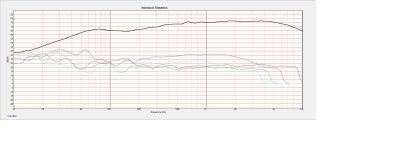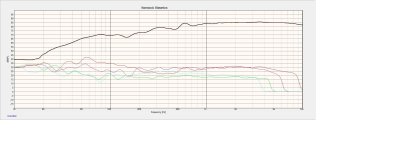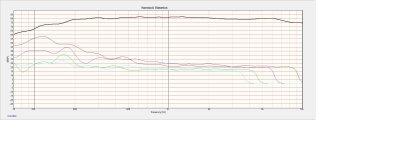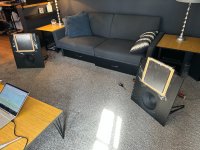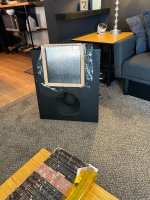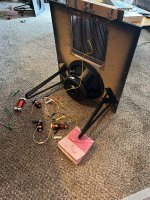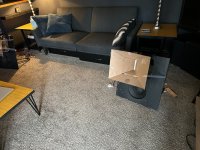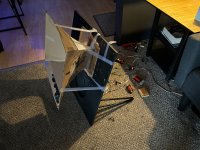Built some single ended planers recently and noticed in distortion measurements the 3rd harmonic was higher than the 2nd harmonic. Is this typical for single ended magnet planers?? None of the free swinging ribbons I've made do this. Has anyone done a compare of distortion measurements between single sided magnet and push pull arraignments? Note the purple line above all the rest in the attached pic
Attachments
update...
It turned out to be an amplifier issue. At low volumes the 3rd harmonic is elevated but at listening volumes and higher it comes down. See first attached
BTW this build is an attempt to take the planer to around 200-300 hz rather than the typical 500 -600 hz that the larger commercially available units do. This because so many larger woofers simply dont match all that well to the planers, or ribbons for that matter, above about 250 Hz.
I like the idea of the woofer doing the "power region" roughly below about 400hz, however most reasonably priced 12-15 inch woofers IMO just dont sound that good crossed that high. Eventually the plan is to compare a higher end woofer crossed at around 400 to a planer, VS, a more reasonable priced woofer crossed at or below 300 hz to this planer Im working on here. This one is about 12 x 12 inches in size.
It turned out to be an amplifier issue. At low volumes the 3rd harmonic is elevated but at listening volumes and higher it comes down. See first attached
BTW this build is an attempt to take the planer to around 200-300 hz rather than the typical 500 -600 hz that the larger commercially available units do. This because so many larger woofers simply dont match all that well to the planers, or ribbons for that matter, above about 250 Hz.
I like the idea of the woofer doing the "power region" roughly below about 400hz, however most reasonably priced 12-15 inch woofers IMO just dont sound that good crossed that high. Eventually the plan is to compare a higher end woofer crossed at around 400 to a planer, VS, a more reasonable priced woofer crossed at or below 300 hz to this planer Im working on here. This one is about 12 x 12 inches in size.
Attachments
Last edited:
It's also worth noting that what you were trying to measure is nearly impossible in most homes. Once the background noise exceeds the level of distortion you are trying to measure, the data is unreliable.
If you want to measure down to 0.1% distortion, you need to be able to discern something that's 60 dB below the fundamental. You're basically trying to measure 25 dB of noise if your signal is at 85 dB (assuming your system is calibrated and the levels in your graphs are correct). In the original one, you'd need to measure 15 dB. A typical quiet house has about 35 dB of background noise.
The normal fix for this is to set the SPL at 1 meter, then move the microphone closer to the speaker to measure distortion. If you get the level at the microphone at something like 115 dB, you have a better chance of getting useful data (assuming your microphone is still linear there).
If you want to measure down to 0.1% distortion, you need to be able to discern something that's 60 dB below the fundamental. You're basically trying to measure 25 dB of noise if your signal is at 85 dB (assuming your system is calibrated and the levels in your graphs are correct). In the original one, you'd need to measure 15 dB. A typical quiet house has about 35 dB of background noise.
The normal fix for this is to set the SPL at 1 meter, then move the microphone closer to the speaker to measure distortion. If you get the level at the microphone at something like 115 dB, you have a better chance of getting useful data (assuming your microphone is still linear there).
understood
usually I do set at around 100db at 1 meter then move the mic close. we actually have a much quieter place here than most
I have no delusions that my cheap setup is to be taken as lab grade. However it has proven quite useful even at lower volume measurements to see gross issues and that's all I was really after.
Ive never measured at quite this low a volume before and looks like what your saying has shown itself true. I thought it may have been an amp issue.
A while back I had a similar distortion reading with highish 3rd harmonic and it was actually a bad connection to the foil on a ribbon. Strange to me. Not sure how to understand that one?
Anyway thanks mattstat
usually I do set at around 100db at 1 meter then move the mic close. we actually have a much quieter place here than most
I have no delusions that my cheap setup is to be taken as lab grade. However it has proven quite useful even at lower volume measurements to see gross issues and that's all I was really after.
Ive never measured at quite this low a volume before and looks like what your saying has shown itself true. I thought it may have been an amp issue.
A while back I had a similar distortion reading with highish 3rd harmonic and it was actually a bad connection to the foil on a ribbon. Strange to me. Not sure how to understand that one?
Anyway thanks mattstat
interesting
yea the connection was corroded somewhat. I tightened the clamp and it went away and the volume went up slightly. This was a small ribbon ( 100mm by 15mm) with a transformer of about 15 to 1 ratio windings. low voltage / high current at he ribbon element
yea the connection was corroded somewhat. I tightened the clamp and it went away and the volume went up slightly. This was a small ribbon ( 100mm by 15mm) with a transformer of about 15 to 1 ratio windings. low voltage / high current at he ribbon element
some pics of the protos in all their ugly glory. Big planer is a small listening window BUT the imaging is rock solid with the limited dispersion, the cross to the woofer at 300 hz is a solid improvement over the typical 500 hz crossover (woofer cleaner down there). Woofer is a pro type 96db PE woofer. Quite good below about 350 hz.
Attachments
Narrow dispersion was intentional in most of Roger Sanders' electrostatics. For some, the head-in-a-vise sweet spot is a reasonable trade for holographic imaging.
yea I really dont like the narrow sweet spot BUT as you say its tempting for its image for sure. The planer traces are tapped so can configure as concentric mid/tweet eventually.
BTW I was surprised this setup likes 6db crossover. With 12db/oct the image collapses into speaker once in a while and low volume listening sounds a bit veiled. At 6 db both issue are gone and overall sound is just better. Never had a speaker where 6db worked well before
BTW I was surprised this setup likes 6db crossover. With 12db/oct the image collapses into speaker once in a while and low volume listening sounds a bit veiled. At 6 db both issue are gone and overall sound is just better. Never had a speaker where 6db worked well before
First order crossovers are tough to pull off with many standard cone/dome drivers. You have to pick them very carefully. Designs from Thiel, Vandersteen, Dunlavy, etc. indicate that it's worth the effort to some though.
Since a well-designed planar can have quite wide bandwidth with high fidelity, they give some extra crossover flexibility.
Since a well-designed planar can have quite wide bandwidth with high fidelity, they give some extra crossover flexibility.
Narrow dispersion was intentional in most of Roger Sanders' electrostatics. For some, the head-in-a-vise sweet spot is a reasonable trade for holographic imaging.
For sure. I built a set of 24" x 48" panels crossed over to a TL woofer at about 110Hz. The dynamics in the sweet spot would debone chickens, and the dispersion was absolutely insane. If I stood up and was essentially out of a direct reflection (think of the panel as a mirror) it sounded like someone threw a sleeping bag over the speaker. It was ridiculous, just unusable outside the sweet spot. But good lord, in the sweet spot it did some amazing things.
https://www.quadesl.com/diy_esl1.html
Also I never liked low order crossovers in this design, so I went with active 4th order to make the blended region as low and narrow as practical. To me the poster child of why you don't have a large blend region is Martin Logan
Sheldon
Last edited:
nice job Stokessd !
Yea the dynamics and imaging was an eye opener for me even on my small flat panel. Talk about seeing into the recording. Love the "debone chicken" phrase ha
question for ya, was the 3M tape of the "VHB" variety?
Also have you ever thought about segmenting the stators with the RC filter method to have ever decreasing driven area size as the frequency goes up? Im thinking about doing it on a planer by tapping into the traces a few times across the diaphragm with appropriate caps. I supose that means VERY low ohm by the time ya get to the last few traces on a planer magnetic but may be ok up that high.
I experimented a bit with the 4 micron polyester film with some 4 micron foil on a big faceted planer years ago. About 1/3 the mass of what Im using presently. The light stuff has a bit quieter background and a tad more HF rise to hammer out. The tradeoff was a lower sensitivity however. It was "polite" compared to the heavier diaphragms
Yea the dynamics and imaging was an eye opener for me even on my small flat panel. Talk about seeing into the recording. Love the "debone chicken" phrase ha
question for ya, was the 3M tape of the "VHB" variety?
Also have you ever thought about segmenting the stators with the RC filter method to have ever decreasing driven area size as the frequency goes up? Im thinking about doing it on a planer by tapping into the traces a few times across the diaphragm with appropriate caps. I supose that means VERY low ohm by the time ya get to the last few traces on a planer magnetic but may be ok up that high.
I experimented a bit with the 4 micron polyester film with some 4 micron foil on a big faceted planer years ago. About 1/3 the mass of what Im using presently. The light stuff has a bit quieter background and a tad more HF rise to hammer out. The tradeoff was a lower sensitivity however. It was "polite" compared to the heavier diaphragms
Regarding harmonics: I believe the symmetry of the force exerted on the diaphragm, relative to its neutral position, affects the existence or nonexistence of particular harmonics. (The symmetry of the diaphragm's response plays a role as well.) If the force is symmetric about the diaphragm's neutral position, then that suppresses even order harmonics like the second harmonic. That implies carefully constructed push-pull systems will likely have lower even harmonics relative to similar single-sided designs.
The push-pull system in an ESL is wonderful at suppressing distortion in general because the electric field is essentially uniform between the stators. That makes the force not only symmetric, but also independent of diaphragm deflection. The same does not necessarily hold true for push-pull magnet systems. They might be symmetric, but that doesn't make the magnetic field uniform. So push-pull planar magnetic systems will have a different pattern of harmonics than single-ended designs, but the magical suppression of nonlinearities inherent in the push-pull ESL systems isn't guaranteed.
---
I too had some wide and tall, unsegmented ESL panels that behaved as others have described. The dynamics were like high quality large horns. The "snap" was amazing. Crazy-narrow sweet spot, as everyone has mentioned. I think we might be better off calling the directivity messy rather than narrow, though. The central lobe is indeed super narrow, but the flower blossom of surrounding lobes make it hard to call the directivity truly narrow. Whatever you call it, the sweet spot is the width of your pupil.
Few
The push-pull system in an ESL is wonderful at suppressing distortion in general because the electric field is essentially uniform between the stators. That makes the force not only symmetric, but also independent of diaphragm deflection. The same does not necessarily hold true for push-pull magnet systems. They might be symmetric, but that doesn't make the magnetic field uniform. So push-pull planar magnetic systems will have a different pattern of harmonics than single-ended designs, but the magical suppression of nonlinearities inherent in the push-pull ESL systems isn't guaranteed.
---
I too had some wide and tall, unsegmented ESL panels that behaved as others have described. The dynamics were like high quality large horns. The "snap" was amazing. Crazy-narrow sweet spot, as everyone has mentioned. I think we might be better off calling the directivity messy rather than narrow, though. The central lobe is indeed super narrow, but the flower blossom of surrounding lobes make it hard to call the directivity truly narrow. Whatever you call it, the sweet spot is the width of your pupil.
Few
I wonder though how much the overall subjective effect the non linear drive has when the diaphragm movements are small?
I did some experiments a while back comparing single ended planer units to a design that was extremely linear (sorry cant tell how this was done) and found it didn't seem to matter. Hearing only test but I was surprised. In the end it seemed to me control of diaphragm resonances ( this was manipulated a buch in these tests) was FAR more important.
I did some experiments a while back comparing single ended planer units to a design that was extremely linear (sorry cant tell how this was done) and found it didn't seem to matter. Hearing only test but I was surprised. In the end it seemed to me control of diaphragm resonances ( this was manipulated a buch in these tests) was FAR more important.
I agree it's not a major issue if there's a lot of diaphragm area and therefore little displacement. My own planar magnetic mid-tweeter panels are about 8 feet tall and the mid sections are several inches wide. I think there's so little motion at the loudness levels I use that it's a non-issue. That (and ease of construction) were the reason I went with a single-ended magnet structure. My comments were really focused on the theoretical basis for the types of harmonics.
Few
Few
8 feet and some width Ha!! Big baffle ? What band width are you running with such a thing?
heres a laugh for yall
a 6 inch by 15mm free swing ribbon in a hacked together cardboard horn. good to about 650 hz. 105 db peaks from that little ribbon and keeps up with the 96db pro woofer. Solid as a rock imaging without head in a vise
BUT still the big flat beamy planer beats it for emotional impact
At this point The curved version of this planer ive been working is questionable IMO
heres a laugh for yall
a 6 inch by 15mm free swing ribbon in a hacked together cardboard horn. good to about 650 hz. 105 db peaks from that little ribbon and keeps up with the 96db pro woofer. Solid as a rock imaging without head in a vise
BUT still the big flat beamy planer beats it for emotional impact
At this point The curved version of this planer ive been working is questionable IMO
Attachments
ive noticed quite surprising differences in realism between larger woofers crossed at 350hz vs 500hz. Seems to me that even very linear and expensive pulp or mix woofers, although smooth and flat through to 2 khz, are simply not up to the panels sonics. They measure quite low in distortion plots BUT sure dont sound undistorted to me!
Every one of these types show some deviation in off axis response starting at about 450 hz. So I suspect that where the cone starts to get wonky in flex we are hearing the material properties??
From here it seems to me any well damped materials signature sound is coming into the mix and damped materials have there own color that does not match well with planers stats and ribbons?
Most larger cones, even the cheap ones, seem acceptable below about 300-350. Sooo I went on a tirade to test this by making a planer that could get to 300 with some authority and then do a compare between two scenarios
1- "Paper"( non metal or non exotic sandwich styled) larger woofers crossed at 200-300 to a larger planer
VS
2- metal or sandwich type lager woofers ( clean up to at least 1.5khz) crossed over to a smaller planer at 400-500hz
I haven't bought a decent metal woofer to test yet BUT past experience building large planer woofers with a ribbon or planer tweeter on the side have consistently shown that if the woofer is clean out to about 1.5-2k then there is no issue with crossing at 400-500 hz.
And this way the "power region" is all handled by the woofer wich has some advantages as well
I had some cheap 15 inch "paper" woofers that I recently cut the cones out of and made aluminum cones ( 10 mill thick aluminum from home depot ha) . Their pathetic sensitivity went from bad to worse and the suspensions/ motor could not handle the increased mass BUT at low volume the results show some promise as the region through to about 1 Khz lost its wiggles and tails in the CSD.
Looks like parts express has the cheapest 12 inch aluminum cone I can find. the FR they show looks quite good through the important region. I may try these.
So far I am convinced that an arraignment similar to what you are doing sidesteps the issue completely by taking a very large planer down very low
BUT
My intension was to have a smallish speaker no more than about 3 feet tall that can get a good portion of that sound in a smaller package. I suspect a very clean large woofer at 400 hz is the answer here but will need more work to tell. This way I can use the free swing ribbon and a shallow crossover on woofer to support the ribbons falling response below 1 Khz, OR a smaller planer. Basically the traditional approach done by many in the planer world over the years BUT with a large cone for the bass
I have had some success with this with smaller cheap paper or plastic woofers (8 inch) in boxes BUT in open baffle we definatly need a big one! I supose a bunch of smaller ones may be ok but now your into all sorts of other issues and are getting away from the simple and affordable
Every one of these types show some deviation in off axis response starting at about 450 hz. So I suspect that where the cone starts to get wonky in flex we are hearing the material properties??
From here it seems to me any well damped materials signature sound is coming into the mix and damped materials have there own color that does not match well with planers stats and ribbons?
Most larger cones, even the cheap ones, seem acceptable below about 300-350. Sooo I went on a tirade to test this by making a planer that could get to 300 with some authority and then do a compare between two scenarios
1- "Paper"( non metal or non exotic sandwich styled) larger woofers crossed at 200-300 to a larger planer
VS
2- metal or sandwich type lager woofers ( clean up to at least 1.5khz) crossed over to a smaller planer at 400-500hz
I haven't bought a decent metal woofer to test yet BUT past experience building large planer woofers with a ribbon or planer tweeter on the side have consistently shown that if the woofer is clean out to about 1.5-2k then there is no issue with crossing at 400-500 hz.
And this way the "power region" is all handled by the woofer wich has some advantages as well
I had some cheap 15 inch "paper" woofers that I recently cut the cones out of and made aluminum cones ( 10 mill thick aluminum from home depot ha) . Their pathetic sensitivity went from bad to worse and the suspensions/ motor could not handle the increased mass BUT at low volume the results show some promise as the region through to about 1 Khz lost its wiggles and tails in the CSD.
Looks like parts express has the cheapest 12 inch aluminum cone I can find. the FR they show looks quite good through the important region. I may try these.
So far I am convinced that an arraignment similar to what you are doing sidesteps the issue completely by taking a very large planer down very low
BUT
My intension was to have a smallish speaker no more than about 3 feet tall that can get a good portion of that sound in a smaller package. I suspect a very clean large woofer at 400 hz is the answer here but will need more work to tell. This way I can use the free swing ribbon and a shallow crossover on woofer to support the ribbons falling response below 1 Khz, OR a smaller planer. Basically the traditional approach done by many in the planer world over the years BUT with a large cone for the bass
I have had some success with this with smaller cheap paper or plastic woofers (8 inch) in boxes BUT in open baffle we definatly need a big one! I supose a bunch of smaller ones may be ok but now your into all sorts of other issues and are getting away from the simple and affordable
This set of measurements on a 12" B&C pro sound woofer might be of interest. The impedance plot (figure 1) shows clearly bumps starting in the high-hundreds of Hz range, which I'm assuming are where the cone break-up commences. The directivity plot (figure 13) shows that it narrows significantly starting between 500 Hz and 1 kHz. Perhaps those data can guide your exploration of why you hear what you hear with large woofers and various crossover points.
I ran six 8" open baffle woofers per side with my planar towers for several years, with no subwoofers. I "goosed" the low end to extend the bass which worked well for music, but home theater stuff could overdrive the woofers. So I added a pair of sealed subs and the open baffle 8-inchers thank me daily. I still use the open baffle well below 100 Hz, but I'm not trying to get anything out of them below 50 Hz or so. Seems to retain the bass quality I really like with the open baffles, without sacrificing the bottom octaves. All at the cost of more boxes, more drivers, more money... So I fully understand your goal of keeping things a bit more reasonable.
If you haven't already (I confess I didn't check) you might see how folks are doing trying to replicate Clayton Shaw's Caladan speakers. They use large woofers, open baffle, with a single driver for upper mids and highs. Maybe those woofers would work with your panels? At least there are lots of first-hand reports from listeners you could check out.
Few
I ran six 8" open baffle woofers per side with my planar towers for several years, with no subwoofers. I "goosed" the low end to extend the bass which worked well for music, but home theater stuff could overdrive the woofers. So I added a pair of sealed subs and the open baffle 8-inchers thank me daily. I still use the open baffle well below 100 Hz, but I'm not trying to get anything out of them below 50 Hz or so. Seems to retain the bass quality I really like with the open baffles, without sacrificing the bottom octaves. All at the cost of more boxes, more drivers, more money... So I fully understand your goal of keeping things a bit more reasonable.
If you haven't already (I confess I didn't check) you might see how folks are doing trying to replicate Clayton Shaw's Caladan speakers. They use large woofers, open baffle, with a single driver for upper mids and highs. Maybe those woofers would work with your panels? At least there are lots of first-hand reports from listeners you could check out.
Few
- Home
- Loudspeakers
- Planars & Exotics
- distortion question for you planer makers
